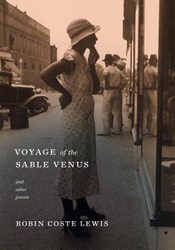
“All is suffering is a bad modernist translation,” Robin Coste Lewis explains. “What the Buddha really said is: It’s all a mixed bag. Shit / is complicated. Everything’s fucked up. Everything’s gorgeous.” This binding of seemingly opposing tethers as a means of considering life and all it entails is the most apt description of Lewis’s collection Voyage of the Sable Venus and Other Poems (Knopf). “Everything’s fucked up. Everything’s gorgeous” so neatly traces my pendulum-like emotional response to the poems in this collection. For while this book compellingly and terrifyingly documents the racist patriarchal systems, particularly intersectionality à la Kimberlé Crenshaw, in our modern society (and how those that go way—way—back), Lewis does so with a remarkable hopefulness, and in the face of what would make most rage and/or collapse.
Voyage of the Sable Venus contains three parts. The second (titular) section is conceptual, using titles and/or descriptions of Western art objects that include the black female figure from 38,000 BCE to the present, in order to explore how these forms were “used” in art. Lewis provides a prologue to these poems, laying out her constraints and (with a light touch) her discoveries, including “because black female figures were also used in ways I could never have anticipated, I was forced to expand that definition to include other material and visual objects, such as combs, spoons, buckles, pans, knives, table legs.” Thus making, at least this reader, consider the “work” the black female figure was forced to do not just in the physical realm, the canvas, or in sculpture, but in the quotidian domestic tool—she held belts together, she combed hair. Another discovery was many curators’ decision to remove titles “such as slave, colored, and Negro…and replace these words instead with the sanitized, but perhaps equally vapid, African-American.” Lewis unsanitizes them for us to show the dirty truth. In addition to using titles of works by oppressors, Lewis smartly includes works by black women and/or queer artists, allowing space for those voices as well. With that, we move through time and space via these artworks, and thus the many horrifying tropes the black female body has been ascribed through the ages. This includes the body in pieces (“Heads and Busts / Headless-Footless-Armless”) while also sexualized (“But with a Strong / Incised Vaginal // Opening”). We read the physically harmed body, the bound body, the body carrying bounty/goods such as fruit, the lies about happy black/white relations. In each Lewis often jams titles/descriptions up against one another and—though the titles remain unchanged—gives us new narratives and turns with alterations to punctuation and space. “Isis” and “Aphrodite” become “I Sis Aphro / Dite.” Or, to powerfully change (yet simultaneously point to) the terrible reality: “Negro man strapped to a ladder, Being. / Lashed.”
All of this circles around what Lewis pins down here:
Damaged Black Woman
Standing on Tiptoe
on One End of a SeesawWhile a Caricatured Figure Jumps
on the OtherEnd
If one attempts to balance on one side of a fulcrum, she stands no chance with such a weight working against her. This isn’t a slow tipping of the scales – this is an inevitable defeat, tossing her through the air.
Near the end of the “Voyage of the Sable Venus,” Lewis (via titles) writes:
I send you these few lines in order
To bring you up
On what has been
Happening to me.
—Venus of Compton
This middle section clocks in at nearly eight pages which, by publishing standards, is a full book. Yet it is clear that, while the long poem “Voyage of the Sable Venus” is instrumental in gaining understanding about “what has been // Happening” to Lewis (a woman from Compton), this history, alone, is only a partial picture. Lewis’s inclusion of sections comprised almost entirely of lyrical first-person poetry surrounding “Voyage of the Sable Venus” is not a merely forcing together of her most recent best work. With the first and final sections she pushes back the edges of the frame, showing us her life, not just what informed it through history.
As with “Voyage,” though with more intensity, the first and third sections of the book bear a quiet yet firm and forceful tone—the effect one feels when she is in the presence of someone so quiet, all around them must lean in to hear. The first poem, “Plantation” is linked with a bright thread to the last in the collection: “Félicité.” In both, Lewis attempts to reckon with the fact that “the black side of my family owned slaves.” “Plantation” tells of a doomed relationship with a shape-shifting beloved who, while aggressive, doesn’t judge the speaker for this complicated fact, allowing for a tenderness. “Félicité” is more specific, with Lewis’s method of gaining the undisputable knowledge (via archive) that a woman relative generations back was a slave and, once a free woman, became a slave owner herself. We see her white lover, consider her strolling across her county-sized property. Where most would invert these pieces—give the portrait of that ancestor and the explicit trouble of her legacy first—Lewis expertly inverts, instead having the details initially hinted at surface later for her reader, allowing for a more nuanced payoff.
These sections contain so much—elements of a rich and complicated life, thus far. This includes meditations on The Wiz, a childhood in Compton with deep color divides, surviving molestation, mother buying a copy of Famous Afro-Americans, “So that I could see a photograph of an uncommon colored body— / besides a burnt body, or a bent body, or a bleeding body, or the murdered body” (or MLK Jr.), experiences with her own young son in the near-present. This all has a power that is intensified by that which surrounds it. Thus I cannot-not write about the second poem in this book—“On the Road to Sri Bhuvaneshwari.” It is a long poem, almost ten pages, employing William Carlos Williams’ triadic stair-step line extended to quatrains. It is the kind of poem we rarely see now. It is a masterpiece, but quiet—building, weaving, looping back, all telling of a day’s experience in India. There is the story of the goddess Parvati’s burnt body parts strewn across mountains and the speaker visiting one such holy landing site. On the way back, a water buffalo is giving birth in the road, stalling the speaker’s return. The herders force the would-be mother to see and note the dead calf after its birth, explaining, “She must turn around and see / what has happened to her or she will go mad.” This all reappears to the speaker when she is leaving home with her own newborn years later. Suddenly she is Parvati’s charred and scattered self, she is the water buffalo—
I have to go back
to that wet black thing
dead in the road. I have to turn around.
I must put my face in it.
This book is a clear turning back, a consideration of what Lewis most wants to leave behind and forget—the tragedies and horrors that seem to provide nothing but grief, but require examination to avoid insanity from lack of deep understanding of what has traumatized you. This is also clearly a poem regarding literal serious physical injury of some kind, (“Somehow, I am still alive”; “The more I recover, the more I go / blind”). While that recurring thread is a faint one, considering the length of the poem, Lewis weaves it adeptly. She is most explicit near the end of the piece when connecting herself directly to Parvati:
For years, my whole body ran
away from me. When I flew—charred—
through the air, my ankles and toes fell off
onto the peaks of impassable mountains.
As Parvati had to undergo the trial of fire to prove her purity for Shiva, this begs the question: what trials are required for recognition? When is the suffering one has endured enough?
On the dedication page of Voyage of the Sable Venus it states, “for beauty.” Considering Elaine Scarry’s flawed argument (among many) in On Beauty and Being Just about a beautiful object, “Noticing its beauty increases the possibility that it will be carefully handled,” Lewis illustrates that it isn’t so simple—and rarely true. As Lewis’s Buddha states, “It’s a mixed bag.” Voyage demonstrates the elements that formulate an identity, inform a life. There is the personal—the “I” as an agent, a witness, a mind and body present. There is also the historical—all the shit that precedes one’s birth that has an impact, now, even when it traces back to antiquity. Lewis asks, “What can History possibly say?” Everything and nothing, it seems. Yet “This is my life,” Lewis writes (via artworks),
cutting up
old film. Don’t editthe wrong thing out
Derrida explains that “Memory is not just the opposite of forgetting.” And Lewis has shown that to be the case, though hardly in a fatalistic sense. She sees and considers—but cuts, too.
***
[Voyage of the Sable Venus and Other Poems was awarded the 2015 National Book Award. Congratulations to Robin Coste Lewis. –Ed.]




